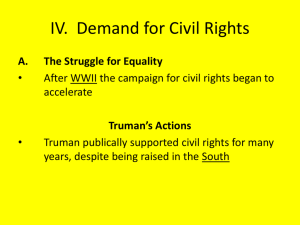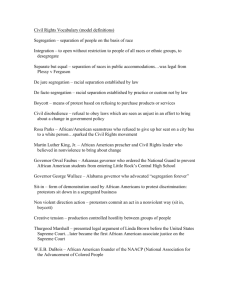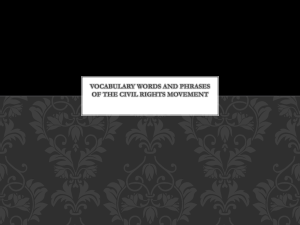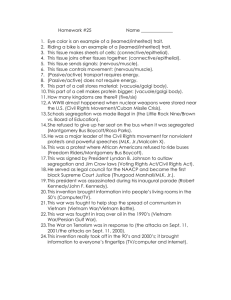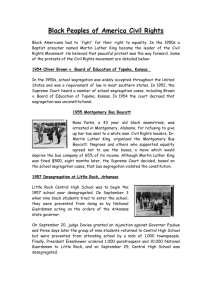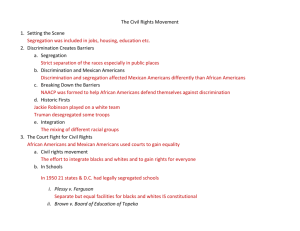IV. Demand for Civil Rights
advertisement
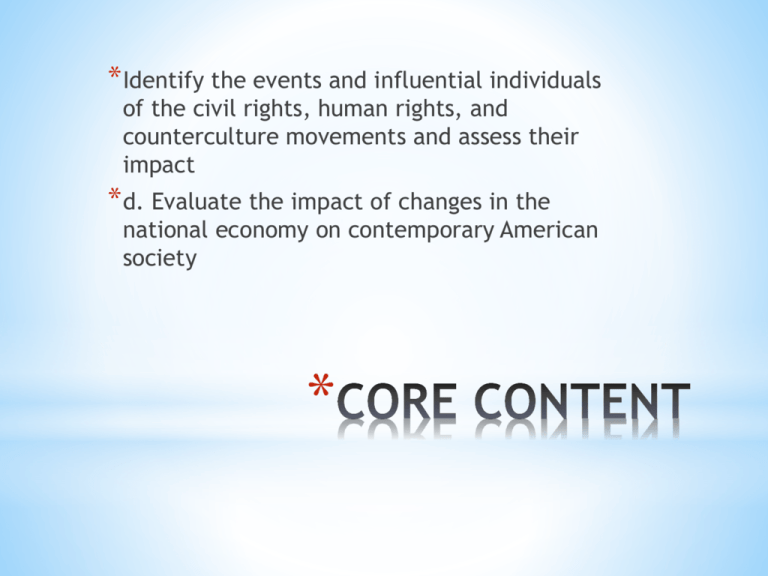
* Identify the events and influential individuals of the civil rights, human rights, and counterculture movements and assess their impact * d. Evaluate the impact of changes in the national economy on contemporary American society * A. * The Struggle for Equality After WWII the campaign for civil rights began to accelerate * *July 1948: Truman banned discrimination in the hiring of federal employees and ordered the integration of the armed forces -change came slowly however – the armed forces weren’t integrated until 1950 * * Date: 1942 * Event: Formation of CORE * Facts: Students in Chicago found the Congress of Racial Equality. * CORE commits to nonviolent direct action to affect change. * CORE protests segregation at a Chicago coffee shop. * Date: (1945 for minor leagues)1947 * Event: First black baseball player in the major leagues * Facts: Jackie Robinson is hired by the Brooklyn Dodgers. * He faces prejudice from fans, teammates, and opposing players. * Other professional sports begin accepting black players at about the same time. Jackie Robinson *For many years, major league baseball had refused to allow African Americans to participate, forcing them to play in the separate Negro Leagues *1945: Brooklyn Dodger general manager Branch Richey decided to challenge the ban * *Richey chose Jackie Robinson to break the color barrier -He had earned letters in football, basketball, baseball, and track while attending UCLA *Before signing him up, Richey attempted to discourage Robinson though insults and threatening violence when he called Robinson into his office -Robinson replied, “Mr. Richey, do you want a ballplayer who’s afraid to fight back?” -Richey answered, “I want a player with guts enough not to fight back.” *1947: Robinson joined the Dodgers, becoming the first African American to play in the major leagues *Despite threats and racial slurs, Robinson acted with dignity and even won the Rookie of the Year award * *Robinson paved the way for other African Americans to play professionally in other sports * * Date: 1948 * Event: Desegregation of the armed forces * Facts: President Truman signs Executive Order 9981. * Executive Order 9981 makes equality of “treatment and opportunity” regardless of race official policy in the armed forces. Brown vs. Board of Education * Probably the greatest civil rights victory in the early postwar period took place in the courts * Plessy v. Ferguson (1896) held that segregation of the races was constitutional as long as facilities were equal – “separate but equal” *Date: 1954 Event: Brown v. Board of Education ruling Facts: A class-action lawsuit against desegregated schools reaches the Supreme Court. -The NAACP, led by Thurgood Marshall, argues that segregation harms black children. -The Warren Court rules that segregation violates the equal protection clause of the Fourteenth Amendment. *1951: Oliver Brown sued the Topeka, Kansas, Board of Education to allow his 8-year-old daughter Linda to attend a school that only white children were allowed to attend -She passed the school on her way to the bus that took her to a distant school for African Americans *After appeals, the case reached the US Supreme Court where lawyer Thurgood Marshall argued on behalf of Brown and against segregation in American schools * *May 17, 1954: The Supreme Court issued its historic ruling by declaring that “separate facilities are inherently unequal” *President Eisenhower, who privately disagreed with the ruling, said “the Supreme Court has spoken and I am sworn to uphold the constitutional processes in this country; I will obey.” *1955: The Court ruled that local school boards should move to desegregate “with all deliberate speed” * Date: 1955–1956 * Event: Montgomery Bus Boycott * Facts: The boycott is sparked by the arrest of Rosa Parks. * On the first day, 90% of African Americans who usually ride the bus honor the boycott. * To make the boycott work, blacks organize an elaborate carpool system. * Martin Luther King Jr. earns a national reputation as a civil rights leader * After the boycott, he and other ministers form the Southern Christian Leadership Conference (SCLC). C. * * * The Montgomery Bus Boycott 1955: The nation’s attention shifted from the courts to the streets of Montgomery, AL Dec. 1955: Rosa Parks took a seat in the middle section of a bus, where both African Americans and whites were usually allowed to sit When a white man got on the bus and had no where to sit, the driver order Parks to give up her seat * *She refused and was arrested at the next stop *Civil rights leaders in Montgomery quickly met and decided to organize the Montgomery Bus Boycott -Called for African Americans to refuse to use the entire bus system until the company agreed to change its segregation policy * *Martin Luther King, Jr., the 26-year- old minister at the church where the initial meeting took place, became the spokesperson for the protest -“There comes a time when people get tired…tired of being segregated and humiliated, tired of being kicked about by the brutal feet of oppression. We have no alternative but to protest.” * *Over the next year, 50,000 African Americans in Montgomery walked, rode bicycles, or joined car pools to avoid the city buses *Despite losing money, the company refused to change its policies *The Supreme Court finally ruled that bus segregation, like school segregation, was unconstitutional * *The bus boycott produced a new generation of leaders in the African American community, particularly King *It also introduced non-violent protest as a means of achieving equality * Date: 1957 Event: Integration of Central High School Facts: Governor Faubus calls out the Arkansas National Guard to prevent integration. President Eisenhower sends in federal troops to maintain order and enforce integration. • Nine African American students attend Central High School this year with military bodyguards and under harassment from white students D. * * * Resistance in Little Rock The Brown decision and the Montgomery protest caused many white southerners to react with fear and angry resistance The worst confrontation came at Central High School in Little Rock, Arkansas 1957: Governor Orval Faubus declared that he could not keep order if he had to enforce integration, or the bringing together of different races * *Faubus posted National Guard troops at the school who turned away nine African American students -His actions was a direct challenge to the Constitution and the ruling of the courts *Eisenhower acted by placing the National Guard under federal command to protect the nine students *Military presence continued during the whole school year * * Date: 1960 * Event: First lunch counter sit-in * Facts: At a sit-in, protesters sit down in a public place and refuse to move. * The first sit-in is held by four black students at a Woolworth’s lunch counter in Greensboro, North Carolina. * They are joined by 20 other people on the second day. * Sit-ins spread across the South. * The Greensboro sit-ins lead to a boycott of Woolworth’s, which eventually agreed to serve blacks. *1960 – Sit-in Movement begins – Feb. 1, 1960, 4 college students from Greensboro, NC went into a Woolworth’s store and sat down at the “whites only” lunch counter and ordered coffee – the waitress refused to serve them – the students stayed seated in silent protest until the store closed – the next day several more students joined them – even more came the following day – the movement spread throughout the South * * Date: 1961 * Event: Freedom Rides * Facts: CORE organizes Freedom Rides to test whether southern states are complying with a Supreme Court ruling that segregation in interstate transportation is illegal. * Freedom riders face violence in Anniston, Alabama, when their bus is bombed. * The Student Nonviolent Coordinating Committee (SNCC) continues the rides after CORE abandons them. *1961 - Freedom Rides begin – boarded buses that would take them across the South - the freedom riders wanted to end segregation on buses and trains – many were beaten and some even killed by angry whites – in Sept. 1961 the Interstate Commerce Commission (ICC) outlawed segregation in interstate travel * * Date: 1963 * Event: March on Washington * Facts: In August, more than 250,000 people march in Washington, D.C. * It is the largest political gathering ever held in the United States. * The most notable event of the day is Martin Luther King Jr.’s “I have a dream” speech. * At the time of the march, a civil rights bill is making its way through Congress. * Date: 1963 * Event: Birmingham campaign * Facts: Birmingham is chosen as a site for a major campaign of nonviolent protests because it is deeply segregated. * King and other demonstrators are arrested and jailed. King writes a letter explaining why African Americans are using civil disobedience to protest segregation. * Police use attack dogs and high-pressure fire hoses to prevent protesters, including children, from marching. * Date: 1964 * Event: Civil Rights Act of 1964 * Facts: Senators opposed to the bill filibuster, but the bill is passed and signed into law. * The law bans discrimination on the basis of race, sex, religion, or national origin. * The law is a landmark act and the most important civil rights legislation passed since Reconstruction. * Date: 1965 * Event: Voting Rights Act of 1965 * Facts: The act outlaws literacy tests and other tactics used to deny blacks the right to vote. * Efforts to secure voting rights prove quite successful. Between 1964 and 1968, the number of blacks in Mississippi registered to vote rises from 7% to 59%. Overall across the South, African American voter registration grows by more than 2 million. * Date: 1959 * Event: The Hate That Hate Produced airs * Facts: This weeklong television special features Malcolm X. * The show brings widespread attention to Malcolm X and the Nation of Islam. * Date: 1965 * Event: Watts riot * Facts: Watts is an African American ghetto in Los Angeles. * In the six days of the riot, 34 people die, almost 900 are injured, and nearly 4,000 are arrested. * After more riots erupt in 1967, the Kerner Commission produces a detailed study of the riots and their causes. * Date: 1966 * Event: Black Panther Party is founded * Facts: Bobby Seale and Huey Newton found the party in Oakland, California. * The Panther’s 10-point platform calls for black self-determination and improvements in jobs, housing, education, and police treatment. * The Panthers provide services for blacks in their community and send out observers to monitor interactions between police and blacks. * The Panthers carry weapons and are prepared to defend themselves. * * Date: 1968 * Event: Civil Rights Act of 1968 * Facts: Congress passes the law days after the assassination of Martin Luther King * Jr., who had taken on the issue of racial discrimination in housing. * The law includes a fair-housing component that bans discrimination in housing sales and rentals. * The law gives the federal government authority to file lawsuits against those who violate the law. * Date: 1969 * Event: Congressional Black Caucus is formed * Facts: In 1968, Shirley Chisholm of New York became the first woman to win * election to the House of Representatives. * In 1969, the black members of the House of Representatives form the caucus. * Over the years, the caucus has worked to address legislative concerns of * African Americans. * Date: 1971 * Event: Swann v. Charlotte-Mecklenburg Board of Education * Facts: This case raises the question of whether de facto segregation caused by housing patterns is constitutional in North Carolina’s Charlotte-Mecklenburg School District. * A year earlier, a federal judge ordered the district to use busing to integrate its schools. * In a unanimous decision, the Supreme Court supports the busing plan. * Date: 1977 * Event: Roots airs * Facts: This 12-hour miniseries is one of the most highly rated shows in TV history. * Based on a historical novel by Alex Haley, Roots tells the story of several generations of an enslaved black family. * More than 250 colleges plan courses around the broadcasts and more than 30 cities have “Roots” weeks. * Date: 1978 * Event: Regents of the University of California v. Bakke * Facts: In the late 1970s, a white male, Allan Bakke, challenged preferential treatment in university admissions. He concluded that he had been refused admission to medical school based on his race and sued for reverse discrimination. * The Supreme Court is deeply divided on the case. Four judges are firmly against any use of race in university admissions. Another four feel just as strongly that race should be used. * Bakke wins the case and is admitted to medical school. The Court declares that race can be used as a criterion for college admission, but cannot be the only criterion *Civil Rights Movement (1945-1970) – Major Events: -1955 – Emmett Till Case -1955-1956 – Montgomery Bus Boycott -1957 – Little Rock public schools * *1963 – Violence in Mississippi - Medgar Evers, a civil rights leader who helped integrate the University of Mississippi (James Meredith was the first African-Am. to be admitted), was shot and killed in his driveway *1963 – Struggle in Birmingham, Alabama – one of the most segregated cities in America – Alabama Governor George Wallace said, “I say segregation now, segregation tomorrow, segregation forever” – police used fire hoses, dogs, and electric cattle prods to break up the demonstrations * *1963 – March on Washington – JFK had proposed a strong civil rights bill – 250,000 gathered in Wash. D.C. to rally support for the bill – Martin Luther King, Jr. delivered his famous “I Have a Dream” speech *1965 – Selma March – voting rights were being denied in Selma, AL – a 30 mile march was held from Selma to the state capital of Montgomery in protest – Alabama State Police met the marchers at the edge of town and fired tear gas into the crowd * *1965 – Watts Riot – a ghetto in LA – riot started when a white police officer arrested an African-American driver on charges of reckless driving – led to 5 days of violence – 34 people died * *Martin Luther King, Jr. -born and raised in Atlanta, GA -from a middle class family – his father was also a preacher -entered college at the age of 15 -based his non-violent method of protest on the teachings of Mohandas Ghandi (leader of India’s revolt against England) -this strategy was designed to provoke violent responses from racist whites that would be covered by the media -… * …hoped the media images would bring outraged responses from all Americans – in turn, this would put pressure on the federal gov’t to intervene and protect the civil rights of African-American citizens -assassinated by James Earl Ray in Memphis, TN (1968) – riots erupted in 60 cities across the country – 37 died * *Malcolm X -born Malcolm Little in Omaha, NE -father was killed by whites when he was a child -ran away to Harlem and was arrested for burglary -while in jail he learned of the Black Muslim movement and its leader Elijah Muhammad -joined the Black Muslims after his release from jail and soon became their spokesperson -believed that African-Americans should separate themselves from whites – opposed integration * -also promoted taking pride in their African culture -traveled to Mecca and came back a changed man – wanted to work more closely with King but was assassinated – probably by members of the Black Muslims (though not proven) *
